Pushing Back the Pain Barrier
This week, we explore the problem of persistent pain. We find out how chronic pain is currently treated, and look to our DNA for the genetic clues that could lead to future painkillers. In the news, a new TB vaccination that stands out on it's own, how babies make sense of broken toys, and why flying in a flock may be exhausting for pigeons. Plus, in Question of the Week, Diana asks why we have a spare copy of some organs.
In this episode
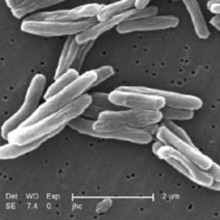
- TB Booster Better Off Alone
TB Booster Better Off Alone
A new study has shown that a breakthrough vaccine against tuberculosis may be more effective when given alone, rather than alongside other vaccines.
 A study by Martin Ota and colleagues on 4-month old West African infants, found that a next-generation TB vaccine, known rather unspectacularly as MVA85A, is significantly less effective when given alongside other, conventional vaccines.
A study by Martin Ota and colleagues on 4-month old West African infants, found that a next-generation TB vaccine, known rather unspectacularly as MVA85A, is significantly less effective when given alongside other, conventional vaccines.
TB is a major health problem worldwide, and the existing vaccine, Bacille Calmette-Guérin, or BCG, named after its inventors, is not entirely effective. The rise of drug-resistant TB strains is making the need for a top-up vaccine in addition to the BCG ever more pressing.
This was the aim of a team at Oxford University that created the MVA85A vaccine. They started with a strain of vaccinia virus - that's the poxvirus which was used as a vaccine to immunize against, and ultimately eradicate, smallpox. The so-called 'Modified Vaccinia virus Ankara', or MVA, was then manipulated genetically to express a protein found on Mycobacterium tubercolosis, called 85A. The immune response against 85A protects against tuberculosis, as it primes the immune system to target the TB-causing bacteria.
The modified vaccinia virus is important because it biases the immune system towards generating killer cells that attack pathogens directly, rather than using soluble molecules like antibodies. This so-called 'cell-mediated' immunity is essential to fighting off TB effectively.
Martin Ota and colleagues at Oxford had already demonstrated that MVA85A is safe and effective at boosting TB immunity in animal models, and preliminary studies on people in Africa and the UK are showing promise. In this latest study, the authors randomly divided a sample of 4-month old children from the Sukuta Health Centre in Gambia into three groups: one group received the standard selection of vaccines called the 'Extended Program of Immunization', or EPI, recommended by the World Health Organization. This includes vaccines against Hepatitis B, diphtheria, tetanus and others. The second group received the EPI plus the new TB vaccine - MVA85A. And the last group received just the MVA85A alone, without the other vaccines.
The scientists then measured the amount of Interferon-gamma (IFN-γ) produced by the participants of the study, at 4 and 20 weeks post vaccination. IFN-γ is a signalling molecule that pushes the immune system towards cell-mediated, rather than antibody-mediated, immunity (and remember that was important for combating TB). They found that MVA85A was significantly better at inducing IFN-γ, and so promoting cell-mediated immunity, when given alone, rather than when given alongside the other vaccines.
This may be because the other vaccines induce antibody responses in the immune system, rather than the killer cell-mediated immunity, and the two immunological strategies are known to inhibit one-another.
So, the study shows firstly that this new TB vaccine is safe, and could work at boosting cell-mediated immunity against TB, and secondly that public health experts may have to re-evaluate how multiple vaccines are given together to children in the developing world.
And that work was published this week in the journal, Science Translational Medicine.
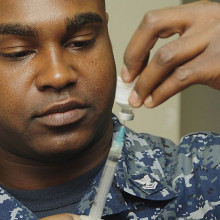
01:46 - TB Booster Better Off Alone
TB Booster Better Off Alone
A new study has shown that a breakthrough vaccine against tuberculosis may be more effective when given alone, rather than alongside other vaccines.
A study by Martin Ota and colleagues on 4-month old West African infants, found that a next-generation TB vaccine, known rather unspectacularly as MVA85A, is significantly less effective when given alongside other, conventional vaccines.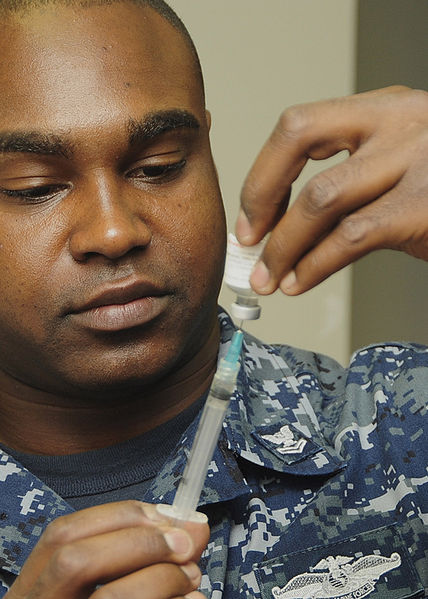
TB is a major health problem worldwide, and the existing vaccine, Bacille Calmette-Guérin, or BCG, named after its inventors, is not entirely effective. The rise of drug-resistant TB strains is making the need for a top-up vaccine in addition to the BCG ever more pressing.
This was the aim of a team at Oxford University that created the MVA85A vaccine. They started with a strain of vaccinia virus - that's the poxvirus which was used as a vaccine to immunize against, and ultimately eradicate, smallpox. The so-called 'Modified Vaccinia virus Ankara', or MVA, was then manipulated genetically to express a protein found on Mycobacterium tubercolosis, called 85A. The immune response against 85A protects against tuberculosis, as it primes the immune system to target the TB-causing bacteria.
The modified vaccinia virus is important because it biases the immune system towards generating killer cells that attack pathogens directly, rather than using soluble molecules like antibodies. This so-called 'cell-mediated' immunity is essential to fighting off TB effectively.
Martin Ota and colleagues at Oxford had already demonstrated that MVA85A is safe and effective at boosting TB immunity in animal models, and preliminary studies on people in Africa and the UK are showing promise. In this latest study, the authors randomly divided a sample of 4-month old children from the Sukuta Health Centre in Gambia into three groups: one group received the standard selection of vaccines called the 'Extended Program of Immunization', or EPI, recommended by the World Health Organization. This includes vaccines against Hepatitis B, diphtheria, tetanus and others. The second group received the EPI plus the new TB vaccine - MVA85A. And the last group received just the MVA85A alone, without the other vaccines.
The scientists then measured the amount of Interferon-gamma (IFN-γ) produced by the participants of the study, at 4 and 20 weeks post vaccination. IFN-γ is a signalling molecule that pushes the immune system towards cell-mediated, rather than antibody-mediated, immunity (and remember that was important for combating TB). They found that MVA85A was significantly better at inducing IFN-γ, and so promoting cell-mediated immunity, when given alone, rather than when given alongside the other vaccines.
This may be because the other vaccines induce antibody responses in the immune system, rather than the killer cell-mediated immunity, and the two immunological strategies are known to inhibit one-another.
So, the study shows firstly that this new TB vaccine is safe, and could work at boosting cell-mediated immunity against TB, and secondly that public health experts may have to re-evaluate how multiple vaccines are given together to children in the developing world.
And that work was published this week in the journal, Science Translational Medicine.
Ben: - I assume the reason that they've given lots of vaccines at once is because they're exposed to a wide range of different potential infection so actually, delaying something that could introduce its own risk.
Will: - Yeah and one of the main reasons why they're given at once is purely practical, just because it's very difficult to get people from remote rural communities and many of these countries in the developing world into the clinics to receive the vaccines and so, it would be much better if you could do it all in one go.

05:27 - Is it Me? Decision Making Babies
Is it Me? Decision Making Babies
Also in the news this week, 16 month old babies can use limited evidence to decide if they have been given a faulty toy, or are just using the toy incorrectly, according to a study published this week in the journal Science.
In order to achieve goals, we need to learn to make this important distinction between faults with ourselves and faults with our environment. For example, if a light switch doesn't work, is it because we pressed the wrong button or because the bulb is broken?
 Scientists from Massachusetts Institute of Technology designed some clever experiments where infants watched an adult pressing a button on a green toy to produce a sound. Next, the baby was handed either the green toy, or an otherwise identical yellow toy, neither of which worked when the baby pressed the button. The infants had to make a decision: were they making a mistake, for example not pressing the toy hard enough? Or was the toy itself broken?
Scientists from Massachusetts Institute of Technology designed some clever experiments where infants watched an adult pressing a button on a green toy to produce a sound. Next, the baby was handed either the green toy, or an otherwise identical yellow toy, neither of which worked when the baby pressed the button. The infants had to make a decision: were they making a mistake, for example not pressing the toy hard enough? Or was the toy itself broken?
When they were presented with the green toy, which they had previously seen working well, babies tended to hand the toy to their parents once they failed, possibly deciding that the fault was with themselves, and their parents would be more successful.
But when they were given the yellow toy, babies were more likely to discard the toy and reach for another, a red one placed nearby. As the babies had no evidence that yellow toys worked at all, they were more likely to believe the fault was with the object, and have another go with a different toy.
But researchers wanted to rule out alternative explanations. Could the babies given the experimenter's toy be less likely to want a new toy? Or were they handing toys over because they thought their parents might be able to fix the toy rather than show them how to use it?
So experimenters showed the babies the green toy again, but this time the babies watched as the same experimenters sometimes succeeded and sometimes failed with the toy, suggesting the fault was with the toy itself. Babies picked up on this, and were more likely to give up on the familiargreen toy and reach for the new red one.
Next, babies watched two different adults - one who consistently failed to produce the noise when they pressed the green toy, and one who always succeeded. After this, babies tended to hand the toy over to their parents, suggesting that the babies were aware there was a 'knack' to it that theyjust hadn't mastered.
These fascinating results show that from a very early age, babies can make evidence based decisions about which response to failure, seeking help or exploring alone, will be most likely to lead to future success. They understand the important distinction between faults with themselves or the worldaround them.
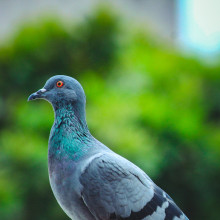
Flock Flying Tires Pigeons
with Dr Jim Usherwood, Royal Veterinary College
Ben - A new analysis of the way that pigeons flock suggests that it actually costs them energy to do so. It's actually more efficient for them to fly on their own. To find out what this could tell us about bird behaviour I spoke to Dr. Jim Usherwood from the Royal Veterinary College...
Jim - Birds fly around in flocks quite a lot. That's something we know about birds. They like to be together. The question has been there for awhile - what are they getting from it? They could easily not fly around in flocks. In the background of bird world we think of lots of rather large birds flying around in Vs. Things like pelicans and geese fly around in nicely ordered Vs. Previous work has shown some kind of benefit from flying in the V. You flap at a lower rate and your heart rate goes down. Indeed, if you fly airplanes in a nicely ordered V they reduce fuel consumption. So, you can fly in such a way that you save energy. Now most birds don't fly around in well structured Vs. Pigeons are a good example of a normal flock termed a 'cluster flock'. Why might they be flying around as a group? We simply didn't know whether they're getting any kind of aerodynamic or energetic benefit from it. What we went about doing is putting, in effect, a Satnav and some internal sensors on every pigeon. A lot of the same kit as you get on an iPhone on every pigeon of the flock. We then got them to fly around we worked out that these birds are probably getting some kind of energetic cost from flying close together. This leads the biologists in us to look for why on earth would you fly in a flock? We need to look for different answers to that now.
Ben - So what were the conditions under which they were flying? Could they have been flocking in response to something that they saw in the environment?
Jim - That's the beauty of these new sensors now, you can leave them on animals. They can wake up when the animals are doing something, and you can let the animals roam free, doing exactly what they would normally be doing. These were put on my flock of racing pigeons which were allowed to do whatever they wanted for 3 days. They're flying around sometimes at 6 o'clock in the morning when nobody was around here. They take off, fly around in flocks for 5, 10 minutes, tens of thousands of flaps, pulling 2G as they go around in circles. They are then sitting down and having a bit more breakfast. They're doing this quite spontaneously. It's very much like a wild flock would do. They are in free flight, but we can take the effects of going up and accelerating, and going around corners into account because we've got so many flaps.
Ben - So how many pigeons were you following and how many wing beats did you actually manage to capture?
Jim - We wired-up up to 20. Not all 20 flew all the time. We're talking about a quarter million of flaps, 400 pigeon kilometres, that we measured. This is just so awesome. It's the sort of data volumes that you would just dream of. If you were trying to do this in a wind tunnel just imagine trying to do that.
Ben - The other question of course is, for all of these pigeons, they have a bit of technology strapped to their back that they wouldn't normally have. Is it possible that the way that you're measuring this is actually having an impact? Is that leading to the fact that they need to fly with greater energy?
Jim - Anything you add to an animal is likely to influence it a bit, especially when it comes to aerodynamics, little bumps sticking up could do untold things with drag. Having said that, they were flying voluntarily and watching from a ground point of view, they were flying around in a flock like they always do. So we've got no particular reason to think they're doing something completely out of the ordinary. Also whatever the effect of having a logger on is presumably the same for all of them. I don't say it's a huge issue but of course, there's always a call for lighter, smoother, better loggers.
Ben - Why are you looking at pigeons in particular when we have other birds that have this glorious V formation or those incredible flocks of starlings that seem almost liquid in the air? Why pigeons?
Jim - Pigeons are pretty useful in that they represent typical flocks. They also have a great advantage that they can carry a fair old payload. These pigeons are quite happy to fly carrying a payload of 30 grams and they come back. So we can just walk up to them in the shed afterwards, pull out an SD card and get a gigabyte of data off them. That makes things a lot easier.
Ben - And what impact did flying in a flock actually have compared to a bird just flying free on its own away from other birds?
Jim - It's actually quite a large difference. If you think of a pigeon flapping along at 8 hertz then as it gets into a flock you've got to 8.1-ish hertz. That doesn't sound much, but if you compare that with how much it changes to flying uphill. If it's flying uphill, it's 4 metres a second. That's a similar kind of change in flap frequency.
Ben - What advantages do you think there may be in flying in a flock? We were saying there's strength in numbers, but then if that strength is counteracted by the fact that you need to put more energy into flight, then it seems that it would be something that would be selected against.
Jim - Yes, so we've got this slight issue that they're presumably primarily flying in order to take exercise here because they're not going anywhere in these flights. They're getting up from their loft, they stream around, and then they're going back for more breakfast. So, is it necessarily a bad thing that they flap a bit harder? Then the prime thing that people will always think of when considering flocks is some kind of a protection from attack. The evidence for that is fairly strong in that when there's a sparrow hawk or something like that around, they tend to bunch in a much greater flock. So, there's probably some advantage of being in a tight flock in terms of being difficult to catch.
Ben - Is this information only really interesting to biologists? Is it only useful for people studying birds or studying flocks?
Jim - Well of course, I'm coming at it from the biologist point of view. There's more and more interest in these autonomous or unmanned air vehicles drones. Flocks of them are becoming more and more useful now. They're always interested in making things more efficient. If you can get a little bit more out of your drone then that's very useful. This would point to not flying your drones around as a flock of pigeons, but keeping in a goose-like structure if you can.
Ben - Jim Usherwood from the Structure and Motion Lab at the Royal Veterinary College in Hertfordshire. You can read about that work in the journal Nature this week.

15:03 - Cracking Histamine's Crystal Structure
Cracking Histamine's Crystal Structure
Good news for hayfever sufferers - by cracking the crystal structure of the histamine receptor, scientists are on the road to developing more effective antihistamine drugs to treat allergy and inflammation.
 Histamine is a molecule produced by special immune cells in response to certain foreign bodies and potentially dangerous pathogens. It has a variety of effects depending on which of the four types of histamine receptor it binds to, named H1 to H4.
Histamine is a molecule produced by special immune cells in response to certain foreign bodies and potentially dangerous pathogens. It has a variety of effects depending on which of the four types of histamine receptor it binds to, named H1 to H4.
Histamine signalling, particularly through the H1 receptor, is known to play a crucial role in a variety of allergic conditions, including hayfever, asthma, food allergies and the itchy response to insect bites.
Conventional antihistamines, such as cetirizine and acrivastine (that's Benedryl Once a Day and Benedryl Allergy Relief respectively), work by blocking the H1 receptor.
Using X-ray crystallography, Tatsuro Shimamura and colleagues unravelled the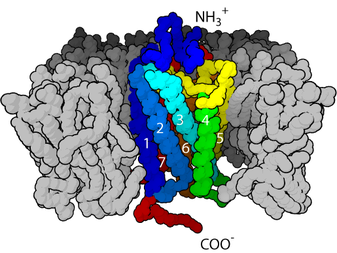 molecular structure of the H1 receptor, with a resolution of 3.1 Angstroms, or 0.00000031mm. So that's very fine detail!
molecular structure of the H1 receptor, with a resolution of 3.1 Angstroms, or 0.00000031mm. So that's very fine detail!
All four of the histamine receptors are part of a much larger family of 'G-protein coupled receptors', or GPCRs, which includes thousands of different proteins. Shimamura's group showed that the first generation antihistamine, Doxepin, interacts at a particular site in the H1 receptor that is found in most G-protein coupled receptors. This explains why doxepin was so non-selective, and hence why it had so many side-effects, including sedation, dry mouth and heart arrhythmias - because as well as blocking H1 receptors, it blocked many other GPCRs as well. In addition, doxepin could cross the blood-brain barrier and block signalling in the brain, adding to the sleepiness.
Second-generation antihistamines, like cetirizine and acrivastine, have far fewer side effects and are considered 'non-drowsy'. The X-ray crystallography suggests that this improvement is due to a second interaction with a different site on the H1 Receptor, in addition to the one that older antihistamines bind to. This second site is not found in other G-protein coupled receptors, which, combined with their reduced uptake across the blood-brain barrier, helps explain their greater selectivity and reduced side effects.
This detailed look at the H1 receptor and its interactions with antihistamines could help guide future drug discovery, so antihistamines used to treat allergies like hayfever may become more effective and with fewer side effects even than current medications.
And that work was published this week in the journal Nature.
Ben - So it's a bit like the old antihistamines where a sort of skeleton key that would fit all of these different receptors and it's only now that we really know the structure can we design exactly the right key that will only interact with the histamine receptors and that should enable us to block hay fever without all of these nasty, sleepy side effects.
Will - Absolutely. The old antihistamines just acted on so many different receptors and it went straight into the brain and so, it had a very blanketing effect on the whole of the brain.

18:17 - Rocking to a Good Night's Sleep
Rocking to a Good Night's Sleep
Katrina - This week has seen breakthroughs into the mysteries of sleep, helping us understand the ancient tradition of rocking babies to sleep, and why we need our shut-eye at all.
Researchers from France and Switzerland have discovered that the rocking motion found in cradles and hammocks not only lulls people to sleep more quickly than lying still, but also encourages deeper sleep.

They asked volunteers to have a 45 minute nap in their 'experimental hammock', which was either still or gently rocking, while an electroencephalogram, or EEG, was used to monitor the waves of activity in their brains.
The study, published this week in Current Biology, found that the rocking motion helped volunteers fall asleep more quickly, with a shorter period of stage 1, or light, sleep. The rocking caused more stage 2 sleep, and increased the number of sleep spindles. These are important patterns of brain activity that seem to be needed to refresh our ability to learn after our sleep.
So rocking helps send us to sleep, and helps deepen our sleep in an afternoon nap. The next step will be to see if the same thing applies for a full night's sleep, and to see if the sleep changes caused by rocking help with learning and memory consolidation. Perhaps rocking beds will soon be standard options in all furniture shops!
But why we need to fall asleep at all? Also in the news this week, fruit flies have taught us more about the role of sleep in refreshing our minds so that they can lay down new memories.
Researchers publishing in the journal Science used fruit flies that were genetically modified to fall asleep if the temperature rises above 31 degrees centigrade. Armed with this ability to induce sleep on demand, they wanted to investigate the 'synaptic homeostasis model', the idea that new connections between nerves are continuously formed when an animal is awake, and these are downscaled during sleep to prevent an overload of circuits.
They showed that flies in a socially enriched environment, with exposure to 90 other flies, formed lots of new connections between nerves. This meant that they were unable to lay down long term memories when researchers tried to train them to suppress their mating rituals. Flies that had been socially isolated, on the other hand, formed fewer new connections between their nerves, and later performed well on the long term memory task.
But can sleep 'refresh' the brain, and abolish the effect of the social enrichment? The researchers used temperature to allow the flies 4 hours of sleep after their social enrichment. This did indeed restore the ability of the flies to form new long term memories, supporting the idea that a period of
sleep simplifies neural connections and leaves the flies better able to learn.
Ben - Is there a bit of a risk with this sort of experiment, similar to that we see with bending animal behaviour experiments that we're actually imposing our own judgment in what they're doing, and it's very, very hard to say exactly why a baby does something, just like it would be hard to say why a bird does something or why a monkey does something?
Katrina - There certainly is that risk, yes and all you can really tell from this study is that there was definitely a significant difference in the decisions that the babies made according to how the experiment has reacted and what toys they were given.
Ben - It would be very interesting and I'm sure there are lots of new parents around who would love to know exactly what their babies are thinking.
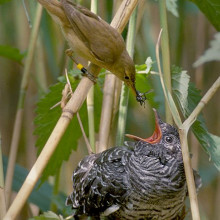
Planet Earth - Cuckoo Trickery
with Professor Nick Davies, University of Cambridge
Ben - Wicken Fen, a National Reserve in Cambridgeshire, is one of Europe's most important wetlands. A vast expanse of meadows, sedge and reed beds. It's home to more than 8,000 species of plants, dragonflies and birds. Nick Davies, a Professor of Behavioural Ecology at the University of Cambridge has been doing fieldwork on cuckoos at Wicken Fen for more than 25 years. They're known as tricksters, cheats, and even parasites. The cuckoo is one of those birds that enthrals nature lovers and it provides scientists with continual insights into its complex behaviour. Planet Earth podcast presenter Sue Nelson joined Nick beside towering reeds on a windy day on the fens to find out more.
 Nick - The way to find cuckoos on Wicken Fen is to go looking with a stick for reed warblers' nests because here on the Fen a reed warbler is the host that the cuckoo targets. And right here in the reeds, if I just part them with this stick, we can see a reed warbler nest...
Nick - The way to find cuckoos on Wicken Fen is to go looking with a stick for reed warblers' nests because here on the Fen a reed warbler is the host that the cuckoo targets. And right here in the reeds, if I just part them with this stick, we can see a reed warbler nest...
Sue - Oh yes.
Nick - ... which is a beautiful cup.
Sue - That's tiny. It would fit in the palm of my hand.
Nick - It would and it's suspended between four new reeds. These keep the reed warbler eggs nice and snug, even on a strong windy day like this. If I just tilt the nest slightly, you can see that it contains four reed warbler eggs. So, so far, this nest has avoided the attention of the cuckoo.
Sue - You're specifically interested in the behaviour of cuckoos and this seems to be an area that is bringing up more and more new insights every year it seems.
Nick - It is. It's been known for a very long time that one of the tricks the cuckoo uses is to lay an egg which mimics the host egg, in other words an egg which looks just like the host egg. Now there are several sub-species or host races of cuckoos in Europe. The ones that we find here on Wicken Fen are specific to reed warbler hosts and they're genetically programmed to lay a green egg which matches the green egg of the reed warbler. It's very well known that this egg matching is really important to fool the hosts, and we've shown that by experiment. If you put a model egg of a different colour into a host nest they'll throw them out. Another form of trickery occurs at the chick stage. When the cuckoo chick hatches it throws all the host eggs out of the nest so it's raised on its own. Here it employs the most wonderful vocal trick. It begs at a fantastic rate which sounds just like a whole brood of hungry host young.
Sue - Now more recently I read about research that involved hawks as well. I would never have put cuckoos and hawks in the same sentence.
Nick - That's right. The tricks I've described so far occur at the egg stage and at the chick stage and we wondered whether the hosts have got a defence early on to try and thwart the cuckoo from laying in the first place. What we discovered is that if reed warblers see a cuckoo at their nest they're much more likely to throw out an egg. We showed by experiment that presenting them with a stuffed adult cuckoo, or a model wooden cuckoo we made out of wood, they became much more fussy if they saw this model close to their nest. They were alerted to the possibility of parasitism. The cuckoo's done two things in response. One trick is actually to mimic hawks by having under-part barring and grey plumage and hawk-like behaviour too with a dashing flight. We think the cuckoo benefits from looking like a hawk because the hosts would then be reluctant to approach this cuckoo or hawk-like object close to their nest. So the cuckoo then has time to slip in and lay without being detected. Now to test whether this cuckoo barring really is the key we presented our model cuckoos either with barred under parts or with unbarred under parts. What we showed is that if the model had barred under parts the reed warbler hosts were much more frightened of it, much more reluctant to approach closely. So actually, the big problem now for the host is that if the cuckoos are so secretive, how can they gauge whether they're likely to be within a cuckoo area and so likely to be targeted as a host? Instead of just relying on their own perception of cuckoo activity, what we've discovered is that the reed warblers also listen out for their neighbours' responses to cuckoos. So it's a bit like a neighbourhood watch system.
Nick - Whenever a reed warbler sees a cuckoo in its territory it mobs with a rasping sound, sort of skrrrr, krrr call. And as soon this rasping call takes place, all the neighbours will quickly come over to see what's going on. And you can see the reeds twitching as the neighbours fly often 20, 30 metres to come and have a look at the source of all this alarming. We've shown by experiment that if they see neighbours mobbing a cuckoo they then up their defences at their own nests. So the cuckoo's really got a double reason for being secretive.
Ben - Professor Nick Davies from the University of Cambridge talking to Sue Nelson at Wicken Fen.

27:09 - Chronic Pain
Chronic Pain
with Dr Mike Bailey, Pain Management Unit at Ipswich Hospital
Will - It is estimated that 7 1/2 million people suffer from chronic pain in the UK alone. A survey published in the European Journal of Pain in 2006 on over 46,000 people in 15 countries, found that nearly 1/5th of all adults had suffered pain for 6 months or more. Combined with the fact that it can be very difficult to find effective treatments, chronic pain is a major problem facing healthcare systems, like the British National Health Service. I travelled to the Pain Management Unit at Ipswich Hospital to speak with Carol Ratcliffe, a retired nurse who has suffered chronic back pain for over 20 years, and with Dr Mike Bailey, the consultant anesthetist and expert in pain management who is now treating Carol, to find out about chronic pain at the front-line of hospital work.
Carol - I first injured my back when I was working over 20 years ago in 1988. I was nursing and I transferred a lady back to her wheelchair. As I moved her, following all the rules and regulations, I felt my back suddenly give and I was in pain. I have not worked since. It has affected me in more ways than even I probably appreciate. I have problems with sleeping because of the pain. I cannot walk any distance. I cannot carry anything. I cannot lift anything. I cannot do a supermarket shop. It has affected me completely and utterly.
Will - That was Carol Ratcliffe and she's receiving treatment from Dr. Mike Bailey, a consultant anaesthetist at the Pain Management Unit in Ipswich Hospital.
Mike - Well Carol's pain is complex and it's being treated in a number of ways. She's got a range of different pain killers. These include both ordinary pain killers such as combinations of paracetamol and codeine, but also pain killers for nerve pain such as nortriptyline and also something called pregabalin.
 Will - And as well as the pain medication that she's taking as tablets, she's also having other types of treatments?
Will - And as well as the pain medication that she's taking as tablets, she's also having other types of treatments?
Mike - Yes, Carol has had several spinal operations. Principally, we do these for patients who've had nerve pain, usually in the legs, coming from problems in the lower back. The surgeons will remove the obstruction to the nerve pathway and hopefully relieve the pain. Carol has had several of those episodes but sadly, like some people, she has still got nerve pain in her legs from the scarring of the nerves from the original problem. In a small number of patients in that sad situation with remaining nerve pain after spinal surgery, we can implant special electrodes to stimulate the spinal cord. What that does is it causes a tingling feeling in the area of the pain and actually relieves the pain by modulating or altering the way in which the nerve messages are sent from the painful legs, up towards the brain.
Will - How does that actually block the pain? How does that electrical signal work?
Mike - What we have been working on for the last 50 years now is something called the 'Gate Control' theory of pain. This was discovered by two scientists in the last century, Patrick Wall, a Neurophysiologist and Anatomist and Ron Melzack who was a Psychologist. What they noticed is that people could get very severe injuries and feel very little pain. Conversely, even very minor injuries or apparently healed injuries could still cause a lot of pain. They said that there must be something that influences the pain. They proposed that there was a so-called gate in the spinal cord in the pathway from the periphery, up towards the brain. We know that in the synapses or junctions between the nerves on that pathway there are chances to change the way in which the pain messages are transmitted. We call that a gate. Now we know that certain things can close that gate and some descending nerve messages down the pathway from higher up in the spinal cord are capable of closing the gate in the nerve pathway. That's I think what the electrical stimulation does. We can use other kinds of electrical stimulation such as a transcutaneous nerve stimulator or TENS machine. That's where we place electrodes on the outer part of the nervous system, on the arm or the leg, but that's not so effective. And of course, some of the painkillers which we use for nerve pain also act on the spinal pathways. A good example of that is amitriptyline, an old fashioned antidepressant, but it's also very effective for pain.
Will - So how effective are all of these treatments at dealing with pain? Do they actually work?
Mike - You can never guarantee anything 100%. If we're looking at analgesics or painkillers, you can look at numbers needed to treat. In other words, how many patients would you need to give that medication to, in order to achieve one satisfied patient. Even for very good painkillers you would need something like 2 to 3 patients in order to get a satisfied customer. Even the more sophisticated treatments like spinal cord stimulation don't have 100% record by any means and there are always side effects for all these treatments.
Will - So pain is normally thought of as a kind of short time response - someone bangs their foot and they get pain. So why is it that in some cases, as with Carol, she had an injury that hurt her back but then the pain has carried on and it never went away properly.
Mike - One of the reasons is that nerves do not recover well from injury and they don't heal up like normal tissues. They will often go on being irritable, almost for life, if they've been badly injured. The other thing is that we don't completely understand all the reasons, but we know that the nervous system sometimes gets a sort of pain memory which can go on causing trouble for years and years. The nervous system is not a static system like the wiring in our house or even in a computer. It's constantly changing and there are changes in the connections in the brain and also lower down in the nervous system to keep old pain circuits going.
Will - Why do you think pain is being so difficult to find treatments for?
Mike - The way in which pain is transmitted throughout the body involves many different pathways and many different neurotransmitters, substances that pass as messengers between nerves. You're having to interfere with that nerve pathway in lots of different ways. We also know that there are lots of things that can influence pain. For instance if you're stressed you will get an increased pain experience as opposed to someone who is calm.
Will - That was Dr. Mike Bailey and Carol Ratcliffe at the Pain Management Unit at Ipswich hospital. Dr. Bailey was also keen to stress that teaching patients psychological coping mechanisms to deal with living with chronic pain is also an important aspect of pain management with the NHS.

Preventing pain
with Professor John Wood, University College London
Katrina - Pain is a huge problem and one that current drugs often fail to answer. To find new ways of blocking pain, scientists are investigating the pain pathway from start to finish - from the tips of our fingers to the depths of our brains. I spoke to John Wood who is Professor of Molecular Neurobiology at University College London. He's one of the leading scientists involved in looking for new ways to interfere with pain.
John - So what happens when you treat joint pain or have some acute pain episode is that there are specialised nerves that innervate all parts of the body - the skin, the muscle, the viscera -- and they've all got various receptors on them that respond to chemicals released from damaged tissue. What will happen is that you'll damage the skin and then some chemicals will activate these sensory nerves and they'll then send an electrical signal into the spinal cord which will activate further neurons up into the forebrain, the cortex, where pain will eventually be perceived.
Katrina - So scientists are beginning to understand the processes involved in sensing pain, but we're still far from conquering this unpleasant sensation with drugs.
John - It's true that we're still dependent upon drugs that have been around for many centuries. Opioid drugs and non-steroidal anti-inflammatory drugs. Aspirin-like drugs are the main stays. We are limited however by the side effect problems of a number of quite potent drugs. I think the estimate is something like 6% of the population are suffering from some quite severe ongoing chronic pain which isn't adequately treated at the moment. That translates into 2 or 3 million people in the United Kingdom who are very poorly treated for ongoing pain as we speak.
Katrina - This may be about to change. New advances in techniques to analyse people's genetics may hold the key.
 John:: Yeah, that's true. It's been quite wonderful - the payoff that's come from sequencing the human genome. It is now possible to get the complete sequence of all the DNA that encodes proteins in a person for about £1,000. It's become terribly straightforward to map mutations which may underlie various pathological conditions including unusual pain states. So, we've been looking around for people with extreme pain syndromes- heritable families which have got either a loss or a gain of pain syndromes. We can then find genes that are obviously significant in terms of normal pain sensation by identifying the mutations that underlie these kinds of pain conditions.
John:: Yeah, that's true. It's been quite wonderful - the payoff that's come from sequencing the human genome. It is now possible to get the complete sequence of all the DNA that encodes proteins in a person for about £1,000. It's become terribly straightforward to map mutations which may underlie various pathological conditions including unusual pain states. So, we've been looking around for people with extreme pain syndromes- heritable families which have got either a loss or a gain of pain syndromes. We can then find genes that are obviously significant in terms of normal pain sensation by identifying the mutations that underlie these kinds of pain conditions.
Katrina - So in order to block pain with effective drugs, we'll need to understand the proteins needed for pain sensation.
John - Genetic studies of people who have a loss of pain sensation have highlighted two different sets of proteins. The first are trophic factors, proteins that are involved in the development of the sensory nerves when you are growing up, even in the uterus. The second set of proteins are the ion channels that are responsible for the electrical signalling that goes on in these cells which are responsible for sending information into the brain that tissue damage has occurred. The two best examples in this area are firstly the trkA Receptor, which is a trophic factor receptor. If you have a mutation in that which stops it working, you don't have any sensory nerves. Secondly is the SCN9A ion channel which is responsible for electrical signalling, particularly in those damaged sensory neurons that cause you to feel pain.
Katrina - Studying people with rare genetic conditions that cause abnormal pain sensation may provide scientists with the information that they need to treat people with any type of pain.
John - Probably the best example comes from a research group in Cambridge led by Professor Geoffrey Woods. He found a gene called SCN9A which is lost in various families that are pain free. This SCN9A gene makes a protein which is called a sodium channel. This is responsible for the electrical signalling in the sensory nerves that we were discussing earlier. So what you can now do is you can take this protein, you can make it in cells, and you can then screen drugs that block its activity. This is what the major pharmaceutical companies have been doing over the last 5 years or so and fortunately, there do seem to be some quite potent new drugs coming up that block this gene product which are effective painkilling drugs. So this is hugely exciting and over the next 5 to 7 years, we hope that some of these compounds will become available in the clinic and will actually be useful additions to the present set of drugs that we can use to treat pain.
Katrina - So the gene identified by Geoffrey Woods' lab is a great example of a potential drug target.
John - Well SCN9A is a very interesting gene because it's been linked to both loss of pain sensation and in some unusual syndromes for people that have ongoing pain. When the gene was sequenced we found out what it actually does and how it's working. It encodes a protein that's involved in electrical signalling. The people that suffer ongoing pain as a result of mutations in this gene have a hyperactive protein. It sends electrical signals into the brain at a very high frequency in response to fairly low level damaging stimuli, whereas people that have got a loss of function of this protein, so that it doesn't work at all, are unable to feel any pain. Interestingly they can't smell because this protein also has a role to play in the olfactory epithelia. This of course gives us a wonderful clue into a potential route to developing new painkilling drugs that act on this gene product.
Katrina - Every day, scientists are stepping closer to conquering pain, but John Wood offers a word of caution.
John - Pain is both a friend and foe because if you're born with a pain-free condition, you have terrible problems injuring yourself all the time. Pain does teach us to protect ourselves and we don't really want to abolish acute pain. What we really want to do is to normalise pain thresholds so that people with things like rheumatoid arthritis or osteoarthritis just have normal levels of pain and are able to sense damaging stimuli, but don't have that ongoing chronic pain which makes their lives a misery. We're making progress both in immunology and in sensory neurobiology in understanding these kind of mechanisms. I'm really actually very optimistic that new drugs will be coming through the next few years that will treat these conditions relatively effectively.
Katrina - That was Professor John Wood from University College London.

41:51 - Naked Engineering - Structural Health Monitoring
Naked Engineering - Structural Health Monitoring
with Dr. Elena Barton, National Physical Laboratory
Meera:: For this week's Naked Engineering, Dave and I are 5 metres above the ground on a bridge that's not really bridging anything. It's about 20 metres long, covered in lots of boxes but with no ends really on either side. There are just ladders down and we're in the middle of a laboratory site. Now Dave, why are we here?
Dave - We're looking to measuring the health of structures. Now for example, biological structure like my arm, if I broke it then I'll get an intense amount of pain and I'll know not to carry onto anything which is damaging it but with something built like a bridge, there's no way of communicating when it's damaged. So small damage can build up and up and up until you could possibly have a catastrophic failure.
bridge, there's no way of communicating when it's damaged. So small damage can build up and up and up until you could possibly have a catastrophic failure.
Meera - One project looking into then how we can predict when something catastrophic say, may happen to a structure like a bridge is the structural health monitoring project taking place at the National Physical Laboratory, and one of the lead scientist on this project Elena Barton.
Elena - There are a few things which are very important when you try to assess the health or the state of the structure. First of all, you need to know what you want to know about your structure, how you want to measure it, and what kind of sensors to use, and where to put the sensors to measure the quantities you want to measure.
Dave - You've actually got to understand your structure quite well before you can even think about measuring it.
Elena - We need to understand more and more how our structure behaves and how we can use it, particularly, if we want to change its use or increase its use.
Meera - Well this bridge that we're on here, it's quite typical of many of the bridges found in the UK that were built in say, the '60s. So with a footbridge like this, what are some of the factors as you mentioned that you would want to sense for then?
Elena - We're looking at material degradation which can manifest itself in additional strain and therefore, we've got strain sensors to measure strain. When we modelled the structure, we identified the areas where we expect to have maximum strain and loading, and therefore, we put the sensors in the square-like areas where you can see electrical resistance, fibre optic sensors and vibrating wire strain sensors. Where we're standing, we can see two sensing patches just on both sides of the column because that has the most strain when the bridge moves.
Dave - So these sensors are basically measuring the actual stretching of the concrete bridge itself. So they're glued in very tightly and they can measure tiny, tiny stretches?
 Elena - Absolutely. The fibre optical sensors will measure strain because the optical fibre will be stretched and the frequency of fibre vibrating will change depending how much the fibre stretched. The vibrating wire sensor, like a musical instrument, when you play a guitar or a violin, the tighter you tighten it, the different frequency you will hear in exactly the same way the vibrating wire will tell us how much strain this bridge is experiencing at that moment in time.
Elena - Absolutely. The fibre optical sensors will measure strain because the optical fibre will be stretched and the frequency of fibre vibrating will change depending how much the fibre stretched. The vibrating wire sensor, like a musical instrument, when you play a guitar or a violin, the tighter you tighten it, the different frequency you will hear in exactly the same way the vibrating wire will tell us how much strain this bridge is experiencing at that moment in time.
Meera - And what causes this strains? What causes it to stretch or contract?
Elena - First of all, it is the usage of the bridge - when we walk along the bridge, when cars go across the bridge, or trains. The other aspect is the environmental condition. When the temperature changes, the material properties of the concrete changes and it expands or contracts, experiencing compression or tensile strain.
Dave - This means you've got several different signals on top of each other. you've got the ones due to things loading, you've got the ones due to environment, and possibly ones due to damage, and you've got to somehow tease out the important data from them.
Elena - That is absolutely correct and that is a very, very difficult thing to achieve.
Meera - But an additional factor you mentioned that you look at is really just what's going on inside of the bridge and that's by monitoring the acoustics?
Elena - If we want to look at deterioration of the bridge, not all deterioration can be visible on the surface. Some damage can occur your inside the bridge, particularly a very common cause for deterioration is corrosion over the reinforcement of the bridge. Acoustic sensors allow us to record any change occurring within the structure.
Dave - So this is literally listening to the bridge. So for example, if you had a twig and it was beginning to break, you'd hears cracking noises. Would you hear something similar with the bridge?
Elena - Absolutely. When the damage occur, the stress wave propagate through the material and we can listen to it. Sometimes the frequencies are different from the frequencies, we can pick up listening to it, and therefore, we need the sensors of different frequencies to detect all the possible damage. The systems we're using on the bridge at the moment, our passive acoustic sensors. They are attached permanently to the surface of the structure and they're continuously listening to any events and it is for us scientists to determine how to interpret the noise and how to interpret different signals.
Meera - So you've got quite a variety of sensors acting on this bridge here, but are you just now leaving them on here to see what naturally happens to this bridge and the concrete within it, or are you actually testing, say particular loads or other factors that could damage it?
Elena - A unique aspect of our project is that although it is a real bridge of a typical construction, it is no longer in use and that's why, we subject it to accelerated damage and damage repair cycles to test how different systems respond to known level of damage. We introduce well-defined damage by removing concrete, cutting through the rebars, and we want to assess how different monitoring technologies detect various levels of damage, and how we can interpret the signal and relate to the damage if the cause of damage is unknown.
Meera - So having monitored then all of these and knowing perhaps the effects of different traffic loads or potentially earthquakes, what is hoped than the applications would be? Is it the case where this whole group of sensors will be found on every bridge in the UK?
Elena - Certainly, not. There are far too many bridges, but what it would allow us to do is that we can rank the existing bridges and we can see what would be the optimal combination of sensors for different task. It is finding the right solution for any possible application in the future and that is why our project is a collaborative project between more than 40 different companies and organisations to investigate how we can provide the reliable, safe, infrastructure for the future generations at minimum cost, and with maximum sustainability.
Can types of pain be related to specific organs or diseases?
Well there's actually a whole different range of types of pain that are associated with different diseases and with different organs. As medical students, Katrina and I have learned about a whole range of these different pains and we've had to learn about how they relate to disease so that we can diagnose what's wrong. So first of all, you have to think about where the pain is. So for example, chest pain might be due to the heart or the lungs or the digestive tracts which are all in that kind of region. Then we consider the character of the pain - so what the pain feels like to the patient. For example, pain due to heart problems is often described as being crushing, like a heavy person sitting on their chest, where as a sharp stabbing pain in the chest, particularly if it worsens when the person breaths in, would be more likely to be associated with the lungs. We also consider what factors make pain better or worse and what brings the pain on. For example, if pain always follows when certain foods are eaten, that would suggest that there's a problem with the digestive tract, like the stomach. However if the pain came on whenever the person did exercise and then went away after a few minutes of rest, that would strongly suggest a heart related problem. If the pain got better when the patient took their medication for heart problems, then obviously that would strengthen the case. Doctors check whether other symptoms accompany the pain, like feeling short of breath, which would push you towards a heart or lung problem. So there's a huge wealth of information that can be gained simply by listening to the patient describe the pain. You can localise it, characterise it, and use all the clues to pin down a diagnosis of the problem.

How does morphine work to kill pain?
Morphine is one of the most famous painkillers. It's an opioid drug, which means it's a cousin of the ancient drug opium, which has been used socially and in medicine thousands of years.
These drugs bind to the opioid receptors, which are on the surfaces of nerve cells in the brain and spinal cord. This sets off a chain of chemical signals within the cell which ultimately cause the cell membrane to become less excitable.
This means that pain-sensing nerve cells become electrically "sluggish" and don't fire so many impulses. As well as dulling pain by silencing nerves in the spine that carry pain signals, morphine also has complex effects in the pain processing areas in the brain, including suppressing the action of the nerve pathways that control breathing, heart rate and blood pressure. This is why an overdose of morphine is so dangerous, because it can trigger a person to stop breathing, which is called a respiratory arrest.
Morphine receptors are also found on nerves all over the body. To cite on example, the nerves that supply the muscles in the gut are slowed down by morphine; this can cause severe constipation, which patients taking opioid drugs need to be made aware of.
How are migraines managed medically?
Classic painkillers, things like ibuprofen, aspirin and paracetamol, can help dull the pain of migraine, just like any other pain. For many people though these drugs really aren't enough. A really odd selection of drugs have been shown to help prevent migraines in the first place actually, things like beta blockers which are generally use to prevent heart attacks and lower blood pressure, anticonvulsant drugs, and even some antidepressants. So, how these drugs help is a bit of a mystery in some cases. Many migraines sufferers still have to go to great lengths to avoid their migraine triggers.
How does Asprin actually work at relieving pain?
Aspirin works by inhibiting the production of certain molecules called prostaglandins. These are responsible for promoting inflammation, swelling and pain in areas of the body that have been damaged. They're produced by an enzyme called cyclo-oxygenase or COX and that's the target that aspirin inhibits and actually blocks it from working by binding to the site where the enzyme has its activity. You mentioned some other over-the-counter drugs like ibuprofen and that's actually the same class of drug as aspirin. It operates in a very similar way. Paracetamol is a bit more tricky and it does seem to inhibit COX, but it also has other actions as well and it may act on the cannabinoid receptors in the brain which are actually the same receptors that respond to cannabis, which itself has some painkilling effects. So paracetamol is a bit different to ibuprofen and aspirin, but they're all classed in a similar category which is different to morphine that we heard about before. Aspirin also has the secondary effect to do with preventing blood clots from forming. It does that when given at a slightly lower dose and also over a longer term. That's why the low dose aspirin is given for people at high risk of heart attacks.
Can you pre-load with painkillers?
Well of course, people do it all the time. Before surgery, people have a painkiller so that when they wake up they're not in agony. It's very common to take the pain relief in advance. You wouldn't necessarily want to take aspirin at high dose every time you do DIY because of course it's got side effects. If it's not a very high chance you're going to hurt yourself you don't want to be taking painkillers all the time.
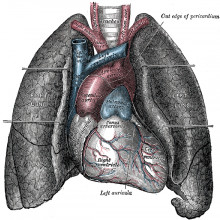
55:58 - Why have one heart but two kidneys?
Why have one heart but two kidneys?
We posed this question to Dr. Sebastian Shimeld from the University of Oxford and Dr. Robert Whitaker from the University of Cambridge.
Sebastian - Now that's a really interesting question and it's really got two answers - one of which is how we develop in the womb, but there's also an evolutionary explanation to this which is how we got to be in this situation in the first place. It's not just us that are bilaterally symmetrical. All vertebrates are - be they birds, reptiles, frogs, or fish. In fact, not just vertebrates but almost all other animals are bilaterally symmetrical as well. This includes worms and flies. This is because bilateral symmetry evolved a very long time ago, at least 500 or 600 million years ago. Our body plan has been locked into bilateral symmetry since that point. This brings me onto the last part of the question which is - could it change? I think given that we've been locked into this body plan for such a long period of time it's unlikely that it's going to change. I wouldn't say completely impossible because there are one or two organisms, or one or two animals, which have managed to change this. A really good example of this is the octopus which not only has a major heart but has managed to evolve two ancillary hearts as well to help its blood flow. So, unlikely to change I think, but perhaps not completely impossible given enough time and the right selection. Diana - And the developmental point of view from Dr. Robert Whitaker at Cambridge University. Robert - The obvious first reaction of many people would be to just suggest that multiple identical organs are simply there for spare parts, but I do not believe that this is the correct explanation. I'd like to look at the conundrum from a developmental point of view. The early embryo has an outer layer, a single midline tube passing from mouth to anus to become the gut. From the single and simple midline tube, is developed the intestines. However many other organs develop from it by a system of budding from the tube. Such organs include the lungs, the liver, the pancreas... and whether these become a single organ or two organs depends on whether the bud that grows from tube stays as a single bud or divides to grow more than one. The liver for instance is a single organ whereas the lung comes from two buds to give the organs that we see in the developed child. So what about the kidneys I hear you ask? Well, they develop not as a single tube, as with the gut, but on either side of the body quite separately. There's a fundamental difference between there being two parts to a single organ, for example the lungs and the brain which all develop from a single outgrowth, as opposed to two separate organs with identical functions such as the kidneys, the ovaries, the testicles, which all develop on separate sides of the body.
Diana - So it's a combination of midline symmetry inherited from our fishy ancestors, a result of our developmental processes as budding embryos and as with many things, it's like that because it works. In some cases, it's always good to carry a spare.
- Previous Cluster-Flock Fatigues Pigeons
- Next Structural Health Monitoring










Comments
Add a comment